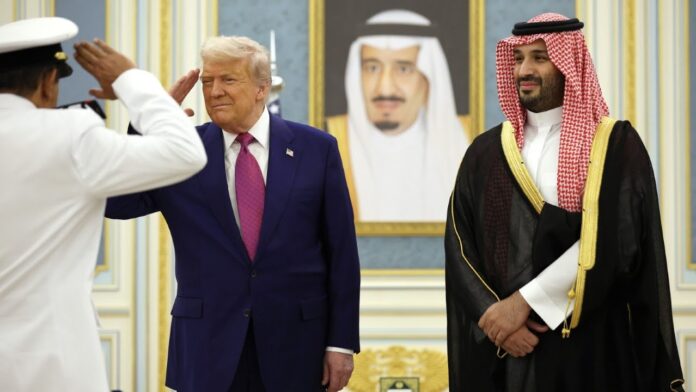Trump stuns allies as he scraps Syria sanctions and clinches historic Saudi defence and trade deals
In a dramatic opening to his Gulf tour, President Donald Trump announced on Tuesday that the United States would lift all sanctions on Syria, marking a stunning reversal of long-standing U.S. policy in the region. The bombshell came alongside an eye-watering $600 billion investment pledge from Saudi Arabia, including the largest arms agreement in U.S. history.
Standing in Riyadh, Trump described the agreement as a “new dawn for peace and prosperity” in the Middle East, while critics and allies alike reeled from the shock move to normalise economic relations with Syria.
The president’s visit to Saudi Arabia triggered a whirlwind of diplomatic and commercial activity, culminating in the $600 billion commitment from Gulf states—chiefly Saudi Arabia—towards investments in U.S. infrastructure, technology, energy, and defence.
“This is the biggest deal anyone’s ever seen,” Trump declared to a packed press briefing. “Saudi Arabia is investing $600 billion in the United States, and we’re lifting the failed sanctions on Syria to open the door to peace, stability, and growth.”
A massive $142 billion slice of the agreement will go directly into U.S. arms sales, according to the White House, making it the most substantial defence cooperation pact ever brokered by Washington.
While Saudi leaders praised Trump for what they described as a “visionary” approach, many international observers were left stunned, particularly over his decision to unilaterally lift sanctions on Syria. These restrictions had been imposed in response to President Bashar al-Assad’s brutal suppression of opposition forces and alleged war crimes.
The move risks inflaming tensions with Europe and sections of the U.S. establishment, where opposition to Assad remains entrenched. However, Trump brushed aside criticism, suggesting diplomacy, not punishment, was the only viable path forward.
“We’ve had enough wars. Enough punishment. Now it’s time for rebuilding,” he said.
Noticeably absent from Trump’s itinerary is a visit to Israel—a deliberate omission that raised eyebrows across the region. His aides offered no explanation, but analysts speculate it reflects Trump’s shifting regional priorities and his desire to court Gulf investment rather than wade into Israeli-Palestinian tensions.
In a further twist, Trump dangled the prospect of renewed talks with Iran. He said the U.S. remained open to a “brighter future” for the Islamic Republic—but warned that failure to agree to a new nuclear deal would trigger “maximum pressure like never before.”
“If Iran wants to prosper, we’re here to talk,” Trump said. “But if they don’t want a deal, they’ll face consequences tougher than anything they’ve seen.”
The flurry of announcements in Riyadh appears carefully calculated to project Trump’s continued dominance on the global stage as he eyes a return to the White House. The blend of muscular diplomacy, economic pragmatism, and headline-grabbing spectacle mirrored the tone of his first term.
While the Saudi deal may inject hundreds of billions into the U.S. economy and defence sector, the decision to lift sanctions on Syria is likely to remain one of the most controversial moves of his trip. Human rights groups swiftly condemned the announcement, warning it would embolden Assad and undermine justice for victims of the Syrian civil war.
Nonetheless, Trump’s supporters heralded the package as a landmark achievement. In Riyadh, Saudi officials hailed a “new chapter” in U.S.-Gulf relations, crediting Trump’s “bold leadership” for sealing the historic pact.
Whether this marks a strategic masterstroke or a diplomatic misstep remains to be seen. But what’s clear is that Trump’s Gulf tour has already made headlines around the world—and raised new questions about the future of U.S. policy in the Middle East.
